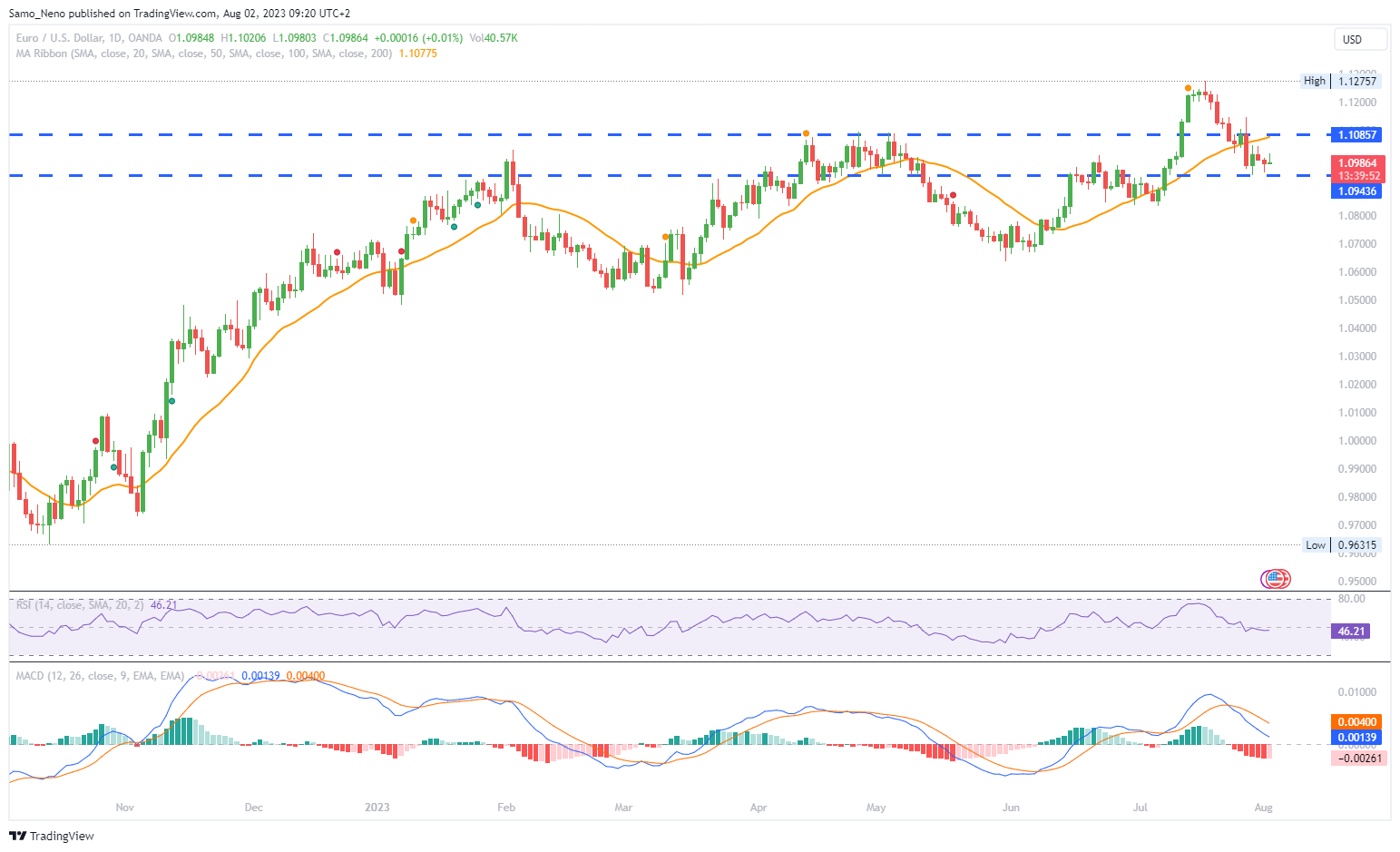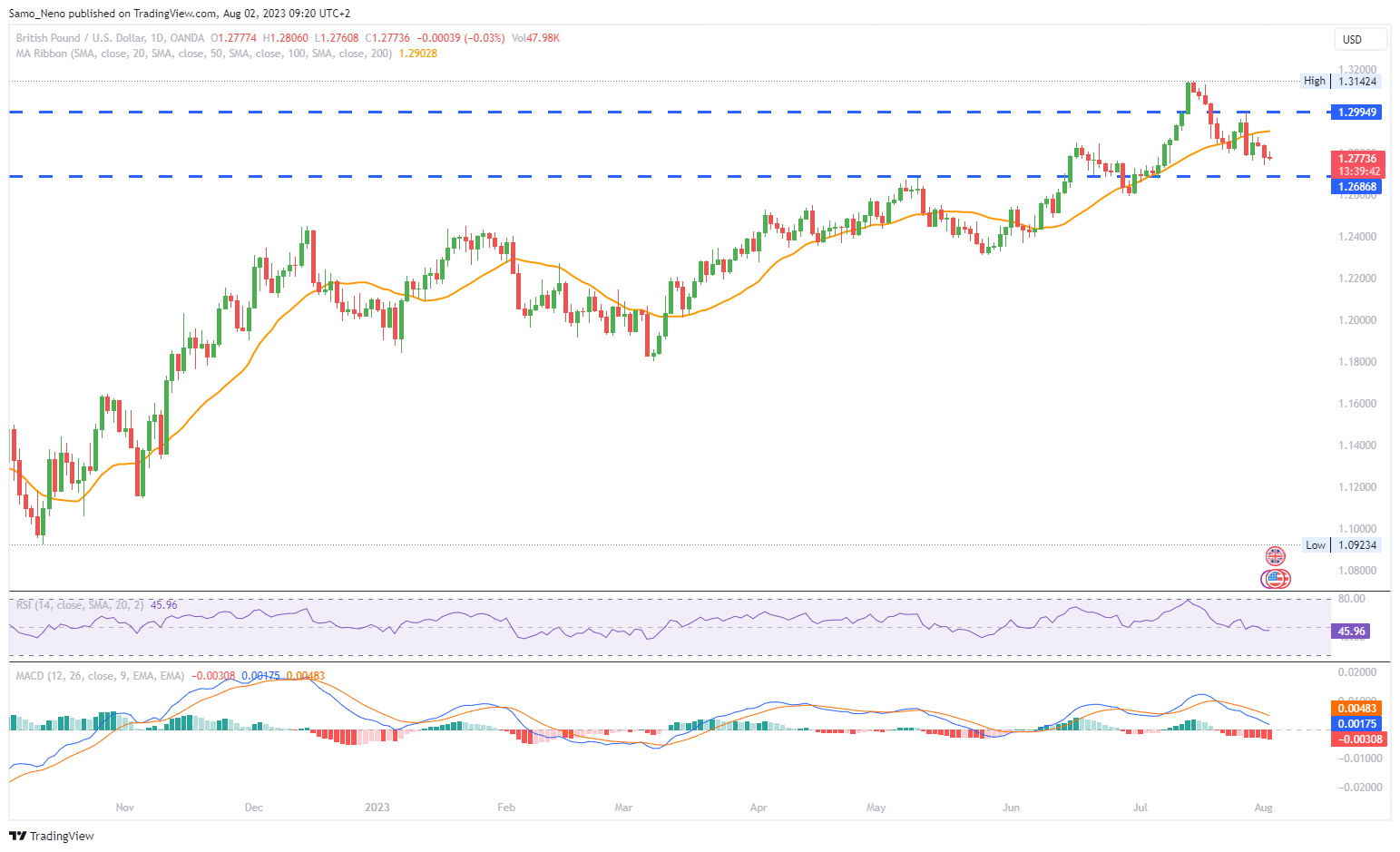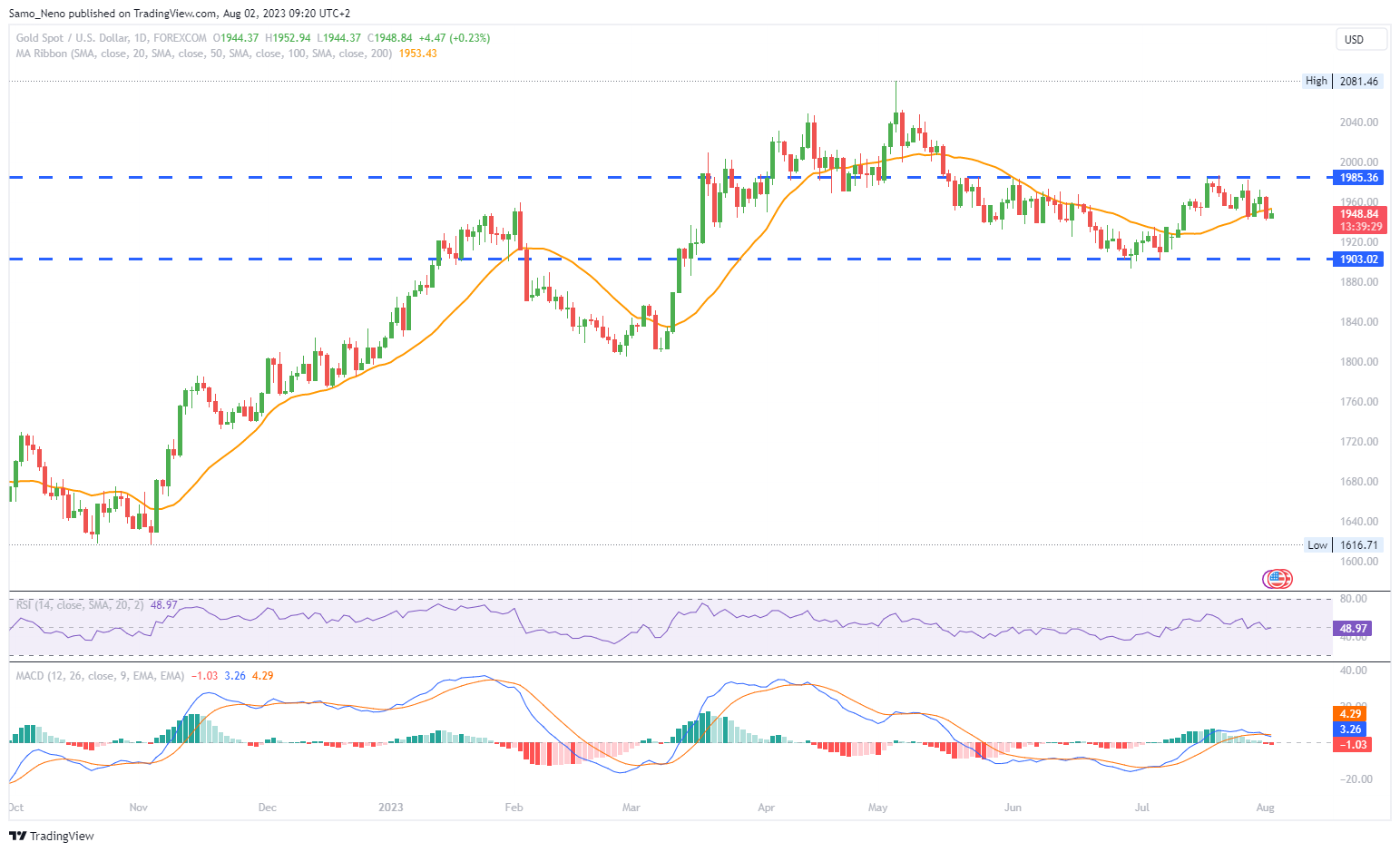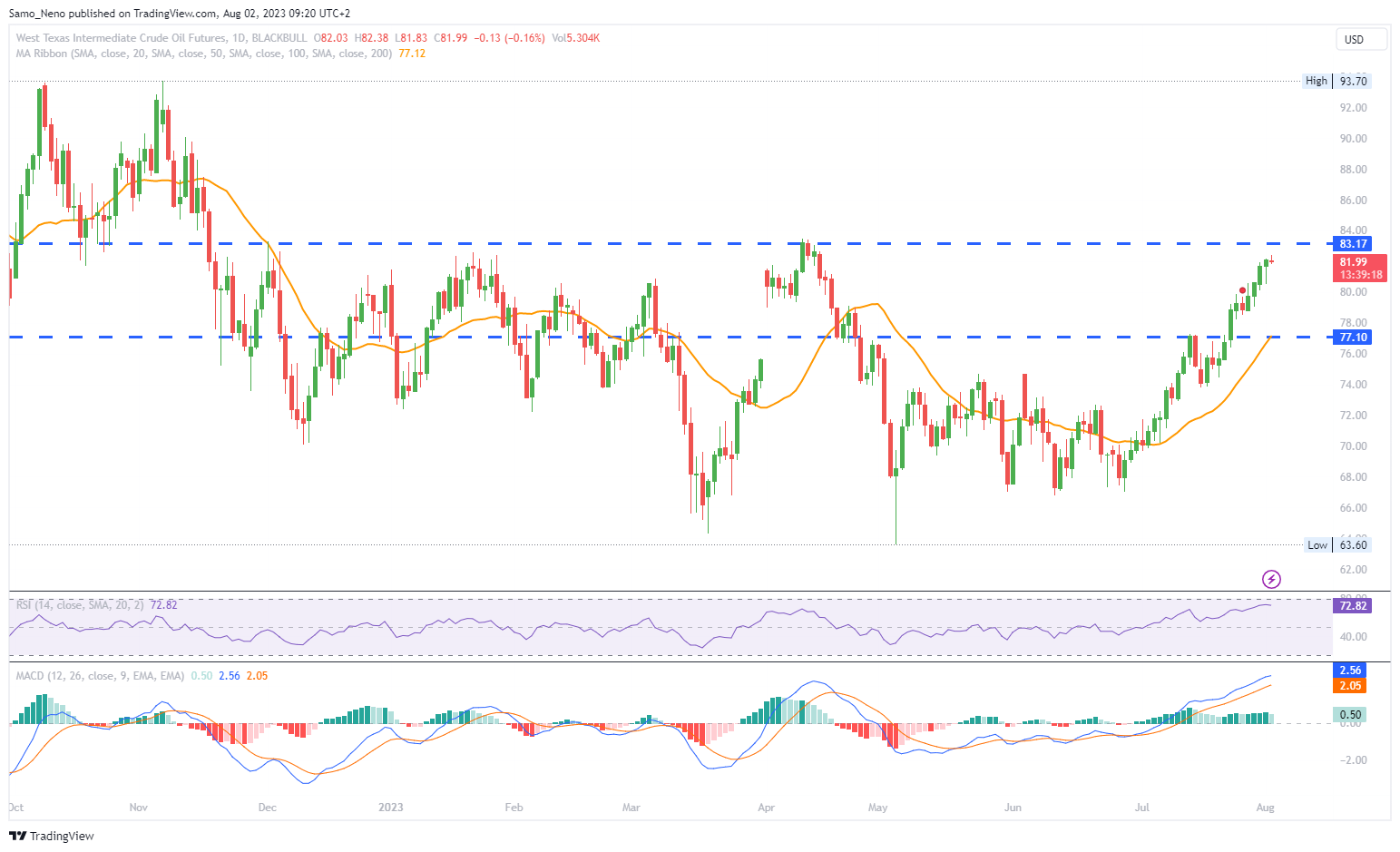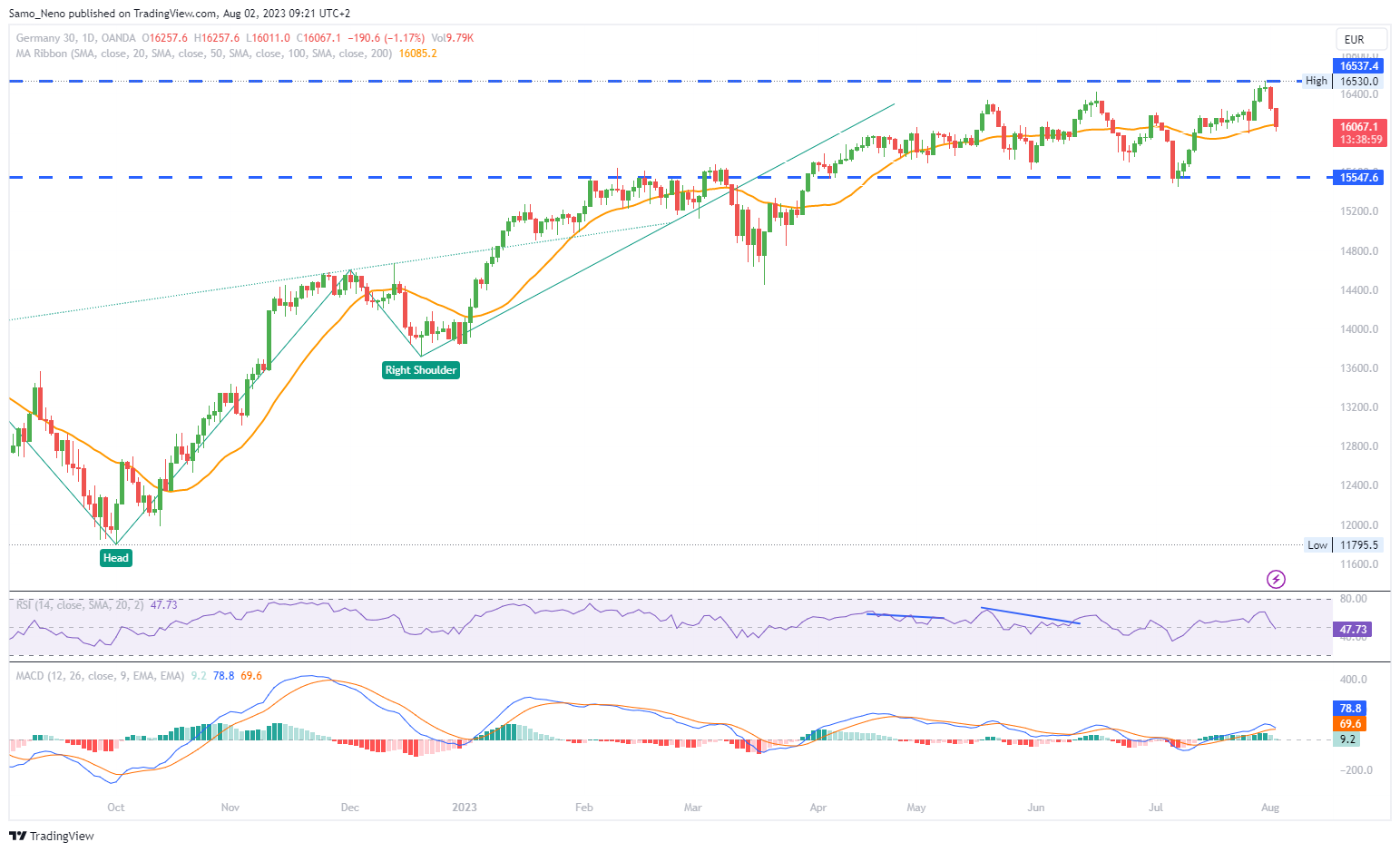EURUSD
- The euro found slight support after Fitch Ratings downgraded the United States' long-term foreign currency issuer default rating from AAA to AA+. This development may have influenced investors' perception of the US dollar's relative strength.
- Both the US Federal Reserve and the European Central Bank are currently adopting a wait-and-watch approach to further tightening, leaving minimal monetary policy advantage from a relative perspective.
- The EUR/USD's recent softness could continue as it faces strong resistance at the 200-week moving average, posing a challenge for further upward movement.
- The final Eurozone PMI remained mostly unchanged at 42.7, indicating continued economic challenges. Moreover, the interest rate market suggests that the likelihood of another rate hike from the European Central Bank (ECB) is below 40%.
- Despite some losses, EUR/USD was supported by signs of economic strength in Europe, highlighted by the Eurozone's record-low unemployment rate and an unexpected decline in Germany's unemployment rate in July.
Closing statement: The euro received modest support following the US's credit rating downgrade, creating a relative advantage for the currency against the US dollar. Both the US Federal Reserve and the European Central Bank are adopting cautious monetary policies, leading to a neutral stance from a comparative standpoint. The EUR/USD faces resistance at the 200-week moving average, potentially limiting its upward movement. Economic challenges in the Eurozone are reflected in the stable PMI, and the interest rate market indicates a low probability of an ECB rate hike. Nevertheless, the euro found support from positive employment data in Europe. The currency pair's future movement will be closely influenced by central bank actions and economic indicators in both regions.
GBPUSD
- The likelihood of a smaller interest rate hike at the Bank of England's meeting is increasing as UK price pressures show signs of moderating from previously elevated levels. This development may influence the pound's performance.
- The dollar index (DXY) rose by +0.42% to a 3-week high, supported by higher T-note yields, which contributed to the dollar's strength against major currencies, including the pound.
- Hawkish comments from Chicago Fed President Goolsbee supported the dollar. He expressed hope that inflation could cool without causing significant economic pain, adding to the dollar's appeal.
- The US JOLTS Job Openings report came below expectations at 9.58 million, and the ISM Manufacturing PMI for July rose to 46.4, slightly below the market's forecast of 46.8. These mixed employment indicators may have implications for the US dollar's performance.
- On Wednesday, the focus will be on more US employment data with the ADP report, providing additional insights ahead of the highly anticipated Nonfarm Payrolls report on Friday, which could have a significant impact on GBP/USD.
| SMA (20) | Slightly Rising |
|
|||
| RSI (14) | Neutral | ||||
| MACD (12, 26, 9) | Falling |
|
|
Closing statement: GBP/USD is facing growing expectations of a smaller rate hike from the Bank of England as UK price pressures moderate. The dollar index (DXY) rose to a 3-week high, supported by higher T-note yields and hawkish comments from a Fed official. The US employment data, including the JOLTS Job Openings and ISM Manufacturing PMI, contributed to the dollar's strength against the pound. With further US employment data coming up, the focus will be on Friday's Nonfarm Payrolls report, likely influencing GBP/USD's movements in the near term.
GOLD
- Gold prices rose slightly on Wednesday, but losses in the prior session resulted in futures losing a key bullish level. The strength of the dollar continued to impact metal prices, including gold.
- Signs of recovery in the US manufacturing sector and construction spending boosted the dollar as investors feared that a resilient US economy might prompt the Federal Reserve to continue raising interest rates. This sentiment weighed on gold and other metals as they tend to perform poorly in a higher interest rate environment.
- The dollar index rallied to a 3-week high, further undercutting metals prices, including gold.
- Chicago Fed President Goolsbee expressed a desire to see a more sustained trend of lower prices before the Federal Reserve stops raising interest rates. His stance could have implications for the dollar and gold prices.
- Gold remains influenced by the dollar's strength and the Fed's interest rate decisions. The market will closely monitor economic data and central bank communications for clues on the future trajectory of interest rates and its impact on gold prices.
| SMA (20) | Slightly Rising |
|
||
| RSI (14) | Slightly Falling |
|
||
| MACD (12, 26, 9) | Slightly Falling |
|
Closing statement: Gold prices experienced some gains after the previous session's losses, but the strength of the dollar and market concerns about the resilience of the US economy weighed on metal prices. The dollar's rally to a 3-week high and Chicago Fed President Goolsbee's stance on interest rates added to the pressure on gold. Investors will continue to closely follow US economic data and central bank communications for insights into gold's outlook amidst the evolving interest rate environment.
CRUDE OIL
- Crude oil prices rose in Asian trade on Wednesday, maintaining over three-month highs. The industry data from the American Petroleum Institute (API) indicated a significant drawdown in U.S. inventories, with estimates suggesting a reduction of 15.4 million barrels in the week to July 28. This substantial drawdown points to tightening supplies in the world's largest economy.
- The reported drawdown of 15.4 million barrels was the largest on record, dating back to 1982. It reflects slowing production and declining global supplies, indicating that crude supplies in the U.S. are rapidly tightening.
- Steady oil demand and weakening global output have led to bets that oil markets will experience substantial tightening this year, which in turn is boosting crude prices.
- The API data reinforces the impact of Saudi Arabia and Russia's efforts to boost oil prices through large production cuts. These production cuts are expected to significantly tighten supplies in the second half of 2023.
- With tightening inventories and global production cuts in place, crude oil prices are likely to be influenced by the balance between demand and supply dynamics, as well as geopolitical factors.
| SMA (20) | Rising |
|
|
|
| RSI (14) | Neutral | |||
| MACD (12, 26, 9) | Rising |
|
|
Closing statement: Crude oil prices surged to over three-month highs, driven by a record drawdown in U.S. inventories of 15.4 million barrels, signaling rapidly tightening supplies in the world's largest economy. Steady oil demand and ongoing production cuts by Saudi Arabia and Russia are expected to exert further pressure on oil markets, leading to potentially higher crude prices in the second half of 2023. Investors will closely monitor the demand-supply dynamics and geopolitical developments to gauge the future trajectory of crude oil prices.
DAX
- European stock markets are expected to open lower on Wednesday due to concerns about slowing economic growth. Risk sentiment has also been impacted by the surprise downgrade of the U.S.'s top-tier sovereign rating by Fitch.
- The DAX futures contract in Germany traded 1.21% lower, indicating a negative sentiment towards the German stock market. Similarly, CAC 40 futures in France dropped 1.22%, and the FTSE 100 futures contract in the U.K. fell 0.83%.
- The German labor market showed unexpected strength in July, with the unemployment change falling by -4,000, contrary to the expectation of an increase of +20,000. The Jul unemployment rate also declined unexpectedly by -0.1 to 5.6%, defying expectations of no change at 5.7%.
- Medical device maker Siemens Healthineers reported a decline in quarterly operating profit and free cash flow due to the slowdown in its rapid COVID-19 antigen test business.
- Vonovia, Germany's largest real estate group, is underperforming Germany's blue-chip DAX index, indicating potential challenges in the country's property sector.
| SMA (20) | Slightly Rising |
| |
| RSI (14) | Falling |
|
|
| MACD (12, 26, 9) | Slightly Falling |
|
Closing statement: The European stock markets, including the German DAX, are facing bearish sentiment amid concerns about slowing economic growth. The surprise downgrade of the U.S.'s top-tier sovereign rating by Fitch has added to risk aversion. Despite some positive signals in the German labour market, the overall market sentiment remains cautious, and investors are closely watching the performance of key companies like Siemens Healthineers and Vonovia in the DAX index. The unfolding economic data and corporate results will guide the market's direction in the coming days.
